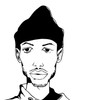Jordan Casteel,James, 2015, Oil on canvas, 72 × 56 in.Courtesy the artist. Photo: Adam Reich
Jordan Casteel, Stanley, 2016 Oil on canvas, 78 × 60 in.Courtesy the artist Photo: Adam Reich
Jordan Casteel, Glass Man Michael, 2016 Oil on canvas, 56 × 72 in. Courtesy the artist. Photo: Adam Reich
Tenses: Artists in Residence 2015–16:, EJ Hill, A Monumental Offering of Potential Energy (installation view) The Studio Museum in Harlem, July 14–October 30, 2016 Photo: Adam Reich
Tenses: Artists in Residence 2015–16: Jibade-Khalil Huffman (installation view)The Studio Museum in Harlem, July 14–October 30, 2016 Photo: Adam Reich
Tenses: Artists in Residence 2015–16: Jibade-Khalil Huffman (installation view)The Studio Museum in Harlem, July 14–October 30, 2016 Photo: Adam Reich
Jibade-Khalil Huffman, Call and Response, 2016 Silkscreen on linen, 36 × 24 in. Courtesy the artist
Tenses: Artists in Residence 2015–16: EJ Hill, Jordan Casteel, and Jibade-Khalil Huffman. Photo: King Texas
